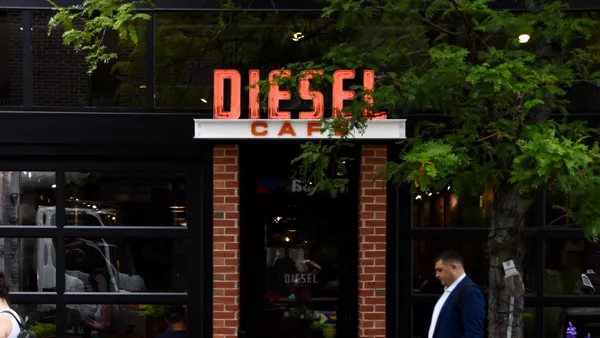Dive Brief:
- U.S. restaurant industry sales were strong in the second quarter, driven by pent-up demand and federal stimulus activity. This has given restaurants the opportunity to pass rising costs from labor and inflation on to consumers, according to research from Fitch Ratings.
- The monthly Food Away from Home Consumer Price Index rose to over 4% in June, after pacing mostly in the lower single-digit range since October 2009, according to Federal Reserve Economic Data cited by Fitch. Prices in the limited-service segment are up even higher — 6.2% — over the year, according to the U.S. Bureau of Labor Statistics' Consumer Price Index Summary.
- Amid these price increases, consumer spending at restaurants still jumped 32% in the April, May and June quarter versus the year-ago quarter, and flat over the same quarter in 2019, according to The NPD Group.
Dive Insight:
Restaurant traffic is still strong despite elevated prices and the looming threat of rising COVID-19 cases. NPD reports that the QSR segment experienced a 15% gain in visits during Q2 2021 compared to Q2 2020 and is down just 5% versus Q2 2019. QSR off-premise orders are also up by 9% over Q2 2019, driven by drive-thru and delivery orders. Meanwhile, total Q2 full-service visits are up by 60% year-over-year, though they remain down by 17% from the same period in 2019.
Perhaps because of that pent-up demand from consumers, several brands expressed comfort in changing prices during the recent round of Q2 earnings calls. During Yum Brands' Q2 call, for example, CFO Chris Turner said, "We are also confident in the pricing power of our brands and partner closely with our franchisees as they make strategic pricing decisions in their respective markets to deal with cost pressures."
Yum CEO David Gibbs added that franchisees use analytics to layer in costs over time so they "don't get too far ahead of the consumer."
Chipotle CEO Brian Niccol said his company has pricing power due to a "tremendous value proposition."
"If we're faced with any headwinds that warrants the need for pricing, I think we can do it with confidence knowing the brand is really strong," he said.
Labor costs are rising, too. Compensation costs within the accommodation and foodservice industry were up 6.2% for the 12-month period ended June 2021 versus 3.1% among all private industry workers, according to the Bureau of Labor Statistics National Compensation Survey.
That said, the industry remains below its pre-pandemic employment levels by about 6%. Fitch Ratings notes that operational efficiencies, many of which were adopted during the pandemic, are also helping restaurants better manage labor pressures. These efficiencies include menu simplification, waste reduction and QR code adoption.
Fitch predicts the employment situation will continue to improve in the industry as vaccination rates increase and federal supplemental unemployment benefits expire in September. Challenges remain, however, as the industry is experiencing its highest quit rate ever as workers demand higher pay. More restaurants are meeting these pay demands. For example, for the first time, the average pay for restaurant workers is now above $15 an hour, according to the Washington Post.













